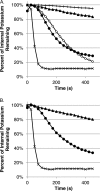The bacteriophage HK97 gp15 moron element encodes a novel superinfection exclusion protein
- PMID: 22797755
- PMCID: PMC3430355
- DOI: 10.1128/JB.00843-12
The bacteriophage HK97 gp15 moron element encodes a novel superinfection exclusion protein
Abstract
A phage moron is a DNA element inserted between a pair of genes in one phage genome that are adjacent in other related phage genomes. Phage morons are commonly found within phage genomes, and in a number of cases, they have been shown to mediate phenotypic changes in the bacterial host. The temperate phage HK97 encodes a moron element, gp15, within its tail morphogenesis region that is absent in most closely related phages. We show that gp15 is actively expressed from the HK97 prophage and is responsible for providing the host cell with resistance to infection by phages HK97 and HK75, independent of repressor immunity. To identify the target(s) of this gp15-mediated resistance, we created a hybrid of HK97 and the related phage HK022. This hybrid phage revealed that the tail tube or tape measure proteins likely mediate the susceptibility of HK97 to inhibition by gp15. The N terminus of gp15 is predicted with high probability to contain a single membrane-spanning helix by several transmembrane prediction programs. Consistent with this putative membrane localization, gp15 acts to prevent the entry of phage DNA into the cytoplasm, acting in a manner reminiscent of those of several previously characterized superinfection exclusion proteins. The N terminus of gp15 and its phage homologues bear sequence similarity to YebO proteins, a family of proteins of unknown function found ubiquitously in enterobacteria. The divergence of their C termini suggests that phages have co-opted this bacterial protein and subverted its activity to their advantage.
Figures


 75 to 95%, and white (□) <35%. The morons, gp15 and gp20, are boxed. The sites of recombination in the HK97/022 hybrid phage are shown with arrows.
75 to 95%, and white (□) <35%. The morons, gp15 and gp20, are boxed. The sites of recombination in the HK97/022 hybrid phage are shown with arrows.


 where lysis of the culture was followed by monitoring the OD600. (B) Samples taken at various time points following mitomycin induction in panel A were lysed with chloroform. The resulting phage lysates were top-plated on E. coli and plaques enumerated, revealing no difference in the number of phage particles produced by the wild-type lysogen (□) compared to a lysogen with pEx15-FLAG (■) and a lysogen with a nonsense mutation in gp15
where lysis of the culture was followed by monitoring the OD600. (B) Samples taken at various time points following mitomycin induction in panel A were lysed with chloroform. The resulting phage lysates were top-plated on E. coli and plaques enumerated, revealing no difference in the number of phage particles produced by the wild-type lysogen (□) compared to a lysogen with pEx15-FLAG (■) and a lysogen with a nonsense mutation in gp15  .
.References
-
- Baba T, et al. 2006. Construction of Escherichia coli K-12 in-frame, single-gene knockout mutants: the Keio collection. Mol. Syst. Biol. 2:2006.0008 doi:10.1038/msb4100050 - DOI - PMC - PubMed
-
- Barondess JJ, Beckwith J. 1990. A bacterial virulence determinant encoded by lysogenic coliphage lambda. Nature 346:871–874 - PubMed
-
- Boulanger P, Letellier L. 1992. Ion channels are likely to be involved in the two steps of phage T5 DNA penetration into Escherichia coli cells. J. Biol. Chem. 267:3168–3172 - PubMed
Publication types
MeSH terms
Substances
Grants and funding
LinkOut - more resources
Full Text Sources
Molecular Biology Databases

